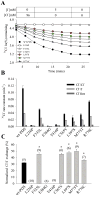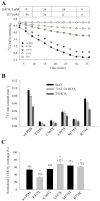Hypo-functional SLC26A4 variants associated with nonsyndromic hearing loss and enlargement of the vestibular aqueduct: genotype-phenotype correlation or coincidental polymorphisms?
- PMID: 19204907
- PMCID: PMC2663020
- DOI: 10.1002/humu.20884
Hypo-functional SLC26A4 variants associated with nonsyndromic hearing loss and enlargement of the vestibular aqueduct: genotype-phenotype correlation or coincidental polymorphisms?
Abstract
Hearing loss with enlargement of the vestibular aqueduct (EVA) can be associated with mutations of the SLC26A4 gene encoding pendrin, a transmembrane Cl(-)/I(-)/HCO(3)(-) exchanger. Pendrin's critical transport substrates are thought to be I(-) in the thyroid gland and HCO(3)(-) in the inner ear. We previously reported that bi-allelic SLC26A4 mutations are associated with Pendred syndromic EVA whereas one or zero mutant alleles are associated with nonsyndromic EVA. One study proposed a correlation of nonsyndromic EVA with SLC26A4 alleles encoding pendrin with residual transport activity. Here we describe the phenotypes and SLC26A4 genotypes of 47 EVA patients ascertained since our first report of 39 patients. We sought to determine the pathogenic potential of each variant in our full cohort of 86 patients. We evaluated the trafficking of 11 missense pendrin products expressed in COS-7 cells. Products that targeted to the plasma membrane were expressed in Xenopus oocytes for measurement of anion exchange activity. p.F335L, p.C565Y, p.L597S, p.M775T, and p.R776C had Cl(-)/I(-) and Cl(-)/HCO(3)(-) exchange rate constants that ranged from 13 to 93% of wild type values. p.F335L, p.L597S, p.M775T and p.R776C are typically found as mono-allelic variants in nonsyndromic EVA. The high normal control carrier rate for p.L597S indicates it is a coincidentally detected nonpathogenic variant in this context. We observed moderate differential effects of hypo-functional variants upon exchange of HCO(3)(-) versus I(-) but their magnitude does not support a causal association with nonsyndromic EVA. However, these alleles could be pathogenic in trans configuration with a mutant allele in Pendred syndrome.
(c) 2009 Wiley-Liss, Inc.
Figures



Comment in
-
The c.-103T>C variant in the 5'-UTR of SLC26A4 gene: a pathogenic mutation or coincidental polymorphism?Hum Mutat. 2009 Oct;30(10):1469-70; author reply 1471. doi: 10.1002/humu.21097. Hum Mutat. 2009. PMID: 19787632 No abstract available.
References
-
- Adler L, Efrati E, Zelikovic I. Molecular Mechanisms of Epithelial Cell-Specific Expression and Regulation of the Human Anion Exchanger (Pendrin) Gene. Am J Physiol Cell Physiol. 2008;294(5):C1261–76. - PubMed
-
- Albert S, Blons H, Jonard L, Feldmann D, Chauvin P, Loundon N, Sergent-Allaoui A, Houang M, Joannard A, Schmerber S, et al. SLC26A4 gene is frequently involved in nonsyndromic hearing impairment with enlarged vestibular aqueduct in Caucasian populations. Eur J Hum Genet. 2006;14(6):773–9. - PubMed
-
- Arwert LI, Sepers JM. Goitre and hearing impairment in a patient with Pendred syndrome. Neth J Med. 2008;66(3):118–20. - PubMed
-
- Badano JL, Leitch CC, Ansley SJ, May-Simera H, Lawson S, Lewis RA, Beales PL, Dietz HC, Fisher S, Katsanis N. Dissection of epistasis in oligogenic Bardet-Biedl syndrome. Nature. 2006;439(7074):326–30. - PubMed
Publication types
MeSH terms
Substances
Grants and funding
LinkOut - more resources
Full Text Sources
Other Literature Sources
Molecular Biology Databases
Research Materials
Miscellaneous

